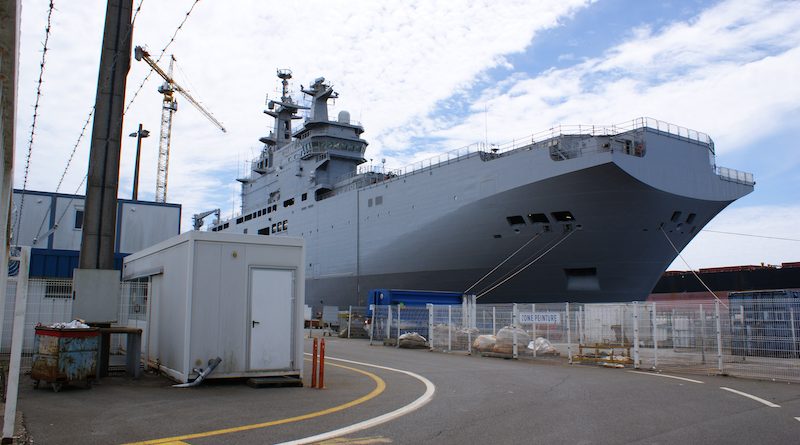High-Tech Import Shortages: The Aftermath of Sanctions in the Russian Shipbuilding Industry
By Maxim Kondratenko, MALD 2022 Candidate, The Fletcher School
On April 7, 2022, Russia’s United Shipbuilding Corporation (USC), together with most of its subsidiaries and affiliates, was included in the United States’ Russian sanctions regime. The USC was targeted specifically for its ownership of facilities that built and conducted repairs on the warships currently participating in the invasion of Ukraine. However, the broad nature of the sanctions combined with the sheer scale of the USC means that the sanctions effectively target Russian shipbuilding as an industry.
Notably, the targets of the sanctions have been restricted in their ability to procure foreign-made components for their ships. The shortage of such high-tech components in the shipbuilding industry is an issue that the government and major industry players have been aware of for a long time, and considerable investment has been poured into increasing output from domestic manufacturers. Import substitution of industrial components critical to the shipbuilding sector was identified as a major development priority in the Russian Ministry for Industry and Trade (Minpromtorg) Strategy for the Development of the Shipbuilding Industry Through 2035. The main issue was that Russian-made components were inferior in quality to those available for purchase abroad and that more concerted government involvement was needed to bolster the industry’s quality standards. By 2035, the plan envisioned that 75 percent of advanced industrial and electronic components would be manufactured by domestic suppliers. The base figure for 2019, as given in the document, was 42 percent.
Available data from the Russian government suggests that Russia’s ability to provide domestically-manufactured shipbuilding components has improved significantly since 2019. In 2021, Director Boris Kabakov of Minpromtorg’s Department of Shipbuilding and Maritime Technology highlighted that as of 2020, 54 percent of the 0.6 billion rubles spent by the shipbuilding industry on technical licenses and components went to Russian domestic manufacturers. However, progress was uneven, as domestic manufacturing was still heavily focused on producing relatively lower-tech components. For advanced components such as engines, machine parts, and electrical equipment, Russian shipbuilding suppliers appear to be lacking. According to Korabel.ru (an industry information resource and database), only eight facilities in the country are currently supplying the aforementioned components.
In addition, the positive numbers at the time of writing are heavily skewed towards military production. Before 2019, 90 percent of government investment in domestic shipbuilding manufacturing was geared towards military production and other government contracts. As a result, Russia’s naval sector has shed its reliance on foreign components, and even managed to produce cutting-edge designs in areas like icebreaking. Other high-tech projects, however, such as the top-of-the-line LNG tankers being manufactured at the new Zvezda shipbuilding complex, still rely almost entirely on foreign suppliers.
The Ministry for Industry and Trade’s 2035 Strategy, as well as Director Kabakov’s 2021 comments, seemed to operate from the basic assumption that Russia’s manufacturing base has the technical and industrial capability to achieve both the quality standards and the higher levels of output that the government hopes to encourage. Other industry reports, however, shed some doubt on this assumption. During the first quarter of 2021, for example, the NEVA International Maritime Exhibition and Conference reported on the issue in the latest iteration of their Russian Shipbuilding Market Analysis. Even taking into account the government’s initiatives, NEVA specifically highlighted the vulnerability of the Russian high-tech marine equipment (MRE) market to foreign sanctions and advocated replacing existing foreign supply contracts with increased domestic production.
Despite the impending shortage of advanced components, it is also widely agreed that the sanctions will not be felt immediately, and work on Russian-manufactured ships is likely to continue. According to analyses of the industry published in Kommersant and New Defense Order Strategy, the underlying reason for what they refer to as the “delayed effect” of sanctions has to do with the timing of material purchases and supply fulfillment. Specifically, most if not all of the advanced components required for Russian dockyards’ current shipbuilding needs had already been procured and delivered before the imposition of sanctions in April. The consensus seems to be that the current rate of manufacturing can be maintained until the end of the year and that the true bite of the sanctions will not be felt in full until early 2023.
Once the existing stockpile runs out, however, all evidence suggests that there will not be enough advanced components to go around. At best, Russia’s domestic industry will be able to supply about 54 percent of the required materials. With the exceptions of Turkish and South Korean companies, all of Russia’s overseas suppliers are subject to sanctions restrictions. Some Russian analysts have expressed the hope that China will function as an alternate provider, but at the time of writing it is not at all clear that the PRC’s major shipbuilders would be able or willing to divert sufficient resources from China’s own robust and growing shipbuilding sector to make up Russia’s 46 percent shortfall. Overall, a severe constriction of Russia’s shipbuilding output is almost certainly inevitable.
Read Maxim Kondratenko’s capstone thesis here: High-Tech Import Shortages: The Aftermath of Sanctions in the Russian Shipbuilding Industry (2022)

